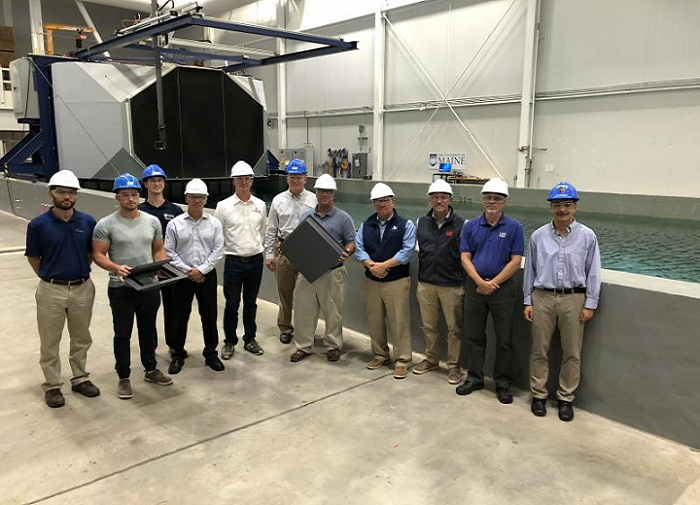This week, the Maine Technology Institute (MTI) awarded the University of Maine Advanced Structures and Composites Center (UMaine Composites Center) a $500,000 grant to form a technology cluster with a very specific purpose – help boatbuilders in Maine gain a competitive advantage in the industry by incorporating large-scale 3D printing with economical wood-filled plastic materials.

L-R: Chris Moran of Compounding Solutions; Kohl Shaw of the UMaine Composites Center; Camerin Seigars of the UMaine Composites Center; Joe Wilson of Compounding Solutions; Nate Thompson of Hodgdon Yachts; James Anderson, UMaine Composites Center senior program manager; Burr Shaw of The Hinckley Company; Kevin Burns of Back Cove/Sabre Yachts; Josh Moore of Lyman-Morse Boatbuilding; Kevin Houghton of Lyman-Morse Boatbuilding; and Habib Dagher, UMaine Composites Center executive director. [Image: the Advanced Structures and Composites Center]
While small and even medium-sized boatbuilders can run into difficulties with the amount of lead time and money it takes to make traditional boat molds and marine tools, UMaine Composites Center researchers say that 3D printing can be used to lower the production time by up to 75%. But even though some companies in the boat and ship industry are using 3D printing, widespread adoption is still slow due to expensive 3D printers and feedstock materials.
That’s why MTI awarded the grant – so the UMaine Composites Center can set up a technology cluster to combine the expertise of marine industry leaders and researchers in order to continue developing and commercializing the technology so boatbuilders in the state can start reaping the benefits.
“The combination of additive manufacturing and cost-effective, bio-filled materials is a potential game-changer for Maine’s boatbuilding industry by reducing the cost of marine tooling by as much as 50 percent. Maine boatbuilders cannot absorb the cost of acquiring a large-scale 3D printer and testing new feedstock materials,” said James Anderson, Senior Research and Development Program Manager at the UMaine Composites Center. “The UMaine Composites Center and the Maine boatbuilding industry share a tradition of innovation. We have the tools and knowledge to help Maine boatbuilders increase productivity, reduce costs and, ultimately, continue their tradition of excellence in the boatbuilding industry.”
Habib Dagher, the center’s executive director, said that for the last 18 years, the center has been busily developing technologies to extrude plastics filled with nanocellulose fibers and wood cellulose; these plastic materials can contain up to 50% wood fiber by weight.
With the help of MTI’s grant, the UMaine Composites Center will address how expensive large-scale 3D printing is, and help to lower the cost, by creating a range of economical wood-filled materials for applications in composite tooling.
“Now, we will use these same stronger and stiffer plastics in very large 3D printers to develop 20- to 100-foot boat molds and other boat parts for Maine boatbuilders. By 3D printing plastics with 50 percent wood, we aim to produce boat molds much faster and cheaper than today’s traditional methods,” said Dagher. “As we learn, we will be working with boatbuilders to incorporate 3D printing in their production process for larger boat parts and, eventually, the boats themselves.”
By using wood-based fillers to 3D print boat molds and parts, the materials’ toughness and stiffness will go up, while the cost will go down. In addition, the materials will help improve recyclability and lower the impact on the environment. The university is also working other companies in Maine to develop a local supply chain for its bio-filled materials, so it’s likely that boatbuilding will not be the only industry to benefit from these research and development efforts.
 The consortium put together by the UMaine Composites Center will collectively design and 3D print boat molds and marine tools for testing and evaluation purposes. Also, as part of the 3D printing adoption and commercialization process, the consortium will be putting together a training course for area boatbuilders.
The consortium put together by the UMaine Composites Center will collectively design and 3D print boat molds and marine tools for testing and evaluation purposes. Also, as part of the 3D printing adoption and commercialization process, the consortium will be putting together a training course for area boatbuilders.
To form the technology cluster of UMaine engineers and researchers, and Maine boatbuilders, the UMaine Composites Center’s $500,000 grant from MTI will be matched by an additional $500,00 from the US Army Natick Soldier Research, Development & Engineering Center. Boatbuilders in the cluster will include Back Cove Yachts in Rockland, Compounding Solutions in Lewiston, Custom Composite Technologies in Bath, Front Street Shipyard in Belfast, Hinckley Yachts in Trenton, Hodgdon Yachts in Boothbay, Kenway Composites in Augusta, Lyman-Morse Boatbuilding in Rockland, and Sabre Yachts in Raymond.
Discuss this and other 3D printing topics at 3DPrintBoard.com or share your thoughts in the comments below.
[Source: Boothbay Register]

45 Replies to “UMaine Composites Center Helping Boatbuilders Incorporate Large-Scale 3D Printing with Wood-Filled Materials”
Comments are closed.